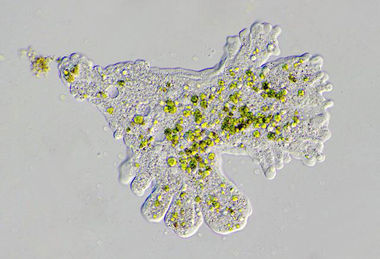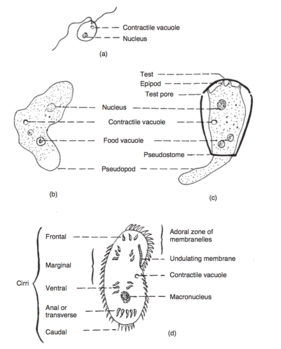Naked amoebae: Difference between revisions
No edit summary |
No edit summary |
||
| Line 1: | Line 1: | ||
[[File: NakedAmoeba.jpg|380px|thumb|right| Figure 1- Naked labose amoeba. Photo showing the polymorphic trait of naked amoeba"]] | [[File: NakedAmoeba.jpg|380px|thumb|right| Figure 1- Naked labose amoeba. Photo showing the polymorphic trait of naked amoeba"]] | ||
=='''Overview'''== | =='''Overview'''== | ||
A Naked [[Amoeba]] is a taxonomic classification of [[soil protozoa]] found in a variety of agricultural, grassland, and forested soils. These are the simplest and most voracious of all the [[soil]] [[protozoa]] and the most dominant in numbers, including a variety of species. [[Naked Amoeba]], as well as other [[protozoans]], | A Naked [[Amoeba]] is a taxonomic classification of [[soil protozoa]] found in a variety of agricultural, grassland, and forested soils. These are the simplest and most voracious of all the [[soil]] [[protozoa]] and the most dominant in numbers, including a variety of species. [[Naked Amoeba]], as well as other [[protozoans]], occupy the tiny microhabitats that are largely unavailable to larger [[soil organisms]], such as "[[Nematodes]]". Like other soil protozoa, these unicellular organisms promote soil [[decomposition]] by enhancing bacterial metabolism, consuming excess bacteria, and excreting simple compounds utilized by plants. <!--just a suggestion but a picture towards the top would look great--> | ||
=='''Habitat'''== | =='''Habitat'''== | ||
Revision as of 11:50, 27 April 2022

Overview
A Naked Amoeba is a taxonomic classification of soil protozoa found in a variety of agricultural, grassland, and forested soils. These are the simplest and most voracious of all the soil protozoa and the most dominant in numbers, including a variety of species. Naked Amoeba, as well as other protozoans, occupy the tiny microhabitats that are largely unavailable to larger soil organisms, such as "Nematodes". Like other soil protozoa, these unicellular organisms promote soil decomposition by enhancing bacterial metabolism, consuming excess bacteria, and excreting simple compounds utilized by plants.
Habitat
Naked Amoeba make up a large portion of microfauna in a variety of soil habitats. The reason for their higher populations in soil is most likely due to the fact that their sliding motion on surfaces enable them to feed on the soil particles, where most of the bacteria grow, and their highly flexible cells are well adapted for grazing activities within the thin water films surrounding the soil particles [4]. They are also members of aquatic freshwater and coastal marine environments, sometime founds in decaying vegetation from streams. Amoebae may also be found in treatment plant recovery from toxic discharge to a treatment plant, areas with low dissolved oxygen levels and waste waste environments. There is still little known about their role in aquatic ecosystems and they are not highly abundant in nature.
Also due to their shape and size, they are easily able to reach very small cavities or pores in the soil aggregates and feed on bacteria that would otherwise be inaccessible to predators [5]. It is common for this variety of soil protozoa to be found in the rhizosphere due to the abundance of bacterial flora surrounding the plant root zones.
To collect amoebae, place a jar upside down so that is it is hovering above the sediment surface. Let air escape so the top layer enters the jar, but try to avoid deeper sediment from entering. If no amoebae are present, add rice grains into the jar and let them rot so the bacteria eating the rice will then be consumed by the amoebae.
Movement & Anatomy

Differing from Testate Amoeba, which have a hard shell, Naked Amoeba do not. Amoebae are polymorphic; a single cell can adopt very different shapes, especially when it is stationary or moves in a non-coordinated manner, often changing the direction of locomotion. They move and feed through the use of pseudopods, which are bulges of cytoplasm formed by the coordinated action of actin microfilaments pushing out the plasma membrane that surrounds the cell. Movement of protists varies greatly amongst species, however it generally involves the polymerization of cytoskeletal proteins (actin and myosin) at the leading edge of the pseudopod, followed by the flow of cytoplasmic material into the vacancy produced through the polymerization process. The flow of cytoplasm provides the momentum necessary to propel the organism [7].
Dietary Processes
Naked Amoeba are phagotrophic, meaning they engulf the entirety of the organism in order to digest it. Phagocytosis involves the process of the amoeba extending its pseudopods and then creating a vacuole of the food within its cytoplasm, which it then digests using enzymes before releasing the processed material into the surrounding environment.

They can consume a variety of food sources, such as bacteria, fungi, algae, and other fine particulate matter in soils. A majority of bacteria consumed in soil is conducted by Naked Amoeba, as they are the most abundant and most efficient at decomposing bacteria [5].
Reproduction
These organisms reproduce asexually via binary fission (mitosis), the splitting of one cell into two genetically identical daughter cells. They also reproduce via syngamy, which is the fusion of two cells.
References
[1] Coleman, D.J., Callaham, M. A., Jr., Crossley, D.A.. November 2017. 'The Fundamentals of Soil Ecology'. Third Edition. Elsevier Academic Press.
[2] Singleton, Paul. 2006. 'Dictionary of Microbiology and Molecular Biology'. 3rd Edition. John Wiley & Sons. https://archive.org/details/dictionarymicrob00sing_558
[3] Bamforth, S.S. 1980. 'Terrestrial protozoa'. J. Protozool. 27, 33–36. https://doi.org/10.1111/j.1550-7408.1980.tb04227.
[4] Clarholm, Marianne . 1981. 'Protozoan Grazing of Bacteria in Soil--lmpact and Importance'. Microbial Ecology.7, p. 343-350.
[5] Foster, R.C., Domar, J.F.. 1991. 'Bacteria-grazing amoeba in situ in the rhizosphere'. Biol. Fertil. Soils 11, p.83-87.
[6] Louiser, J.D., Bamforth, S.S.. 1990. 'Soil Protozoa'. Soil Biology Guide. Wiley, New York, p. 97-136.